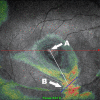Macular holes and macular pucker: the role of vitreoschisis as imaged by optical coherence tomography/scanning laser ophthalmoscopy
- PMID: 18427601
- PMCID: PMC2258095
Macular holes and macular pucker: the role of vitreoschisis as imaged by optical coherence tomography/scanning laser ophthalmoscopy
Abstract
Purpose: The pathogenesis of macular pucker and macular holes is poorly understood. Anomalous posterior vitreous detachment (PVD) and vitreoschisis have been proposed as possible mechanisms. This study used clinical imaging to seek vitreoschisis and study the topographic features of macular pucker and macular holes.
Methods: Combined optical coherence tomography and scanning laser ophthalmoscopy (OCT/SLO) was performed in 45 eyes with macular hole and 44 eyes with macular pucker. Longitudinal imaging was used to identify vitreoschisis and measure retinal thickness. The topographic features of eyes with macular hole with eccentric macular contraction were compared to 24 eyes with unifocal macular pucker using coronal plane imaging.
Results: Vitreoschisis was detected in 24 of 45 eyes (53.3%) with macular hole and 19 of 44 (43.2%) with macular pucker. Retinal contraction was detected eccentrically in the macula of 18 of 45 eyes (40%) with macular hole. In eyes with macular hole with unifocal retinal contraction, the average surface area of contraction (23.12 +/- 18.79 mm(2)) was significantly smaller than in eyes with macular pucker (63.20 +/- 23.68 mm(2); P = .006). The distance from the center of retinal contraction to the center of the macula was significantly greater in eyes with macular hole (8.64 +/- 2.33 mm) than eyes with macular pucker (4.45 +/- 1.90 mm; P = .0001).
Conclusion: Vitreoschisis was detected in about half of all eyes with macular hole and macular pucker. The topographic and structural features in eyes with macular hole with retinal contraction differed in comparison to eyes with macular pucker alone, suggesting that although each condition may begin with anomalous PVD, differences in subsequent cell migration and proliferation probably result in the different clinical appearances detected in this study.
Figures









References
-
- Sebag J. Anomalous posterior vitreous detachment: a unifying concept in vitreoretinal disease. Graefes Arch Clin Exp Ophthalmol. 2004;242:690–698. - PubMed
-
- Messmer EM, Heidenkummer H, Kampic A. Ultrastructure of epiretinal membranes associated with macular holes. Graefes Arch Clin Exp Ophthalmol. 1998;236:248–254. - PubMed
-
- Chen TY, Yang CM, Liu KR. Intravitreal triamcinalone staining observation of residual undetached cortical vitreous after posterior vitreous detachment. Eye. 2006;20:423–427. - PubMed
-
- Snead DRJ, Cullen S, James S, et al. Hyperconvolution of the inner limiting membrane in vitreomaculopathies. Graefes Arch Clin Exp Ophthalmol. 1998;236:248–254. - PubMed
MeSH terms
LinkOut - more resources
Full Text Sources
